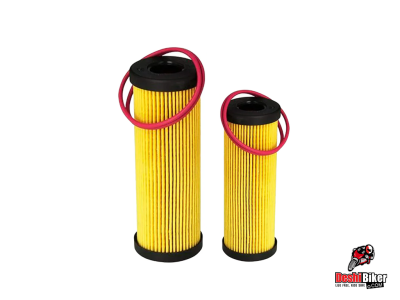What is Slipper Clutch? (Advantages)
What is a Slipper Clutch on a motorcycle? What is the use of a slipper clutch in a bike? Which is better slipper clutch or normal clutch? What are the disadvantages of the slipper clutch? Can we do engine braking without a slipper clutch? Can you shift gears without using the clutch in slipper clutch? How do you downshift with a slipper clutch? Let’s find more detail about the slipper clutch.
What is Slipper Clutch in Bike?
People also know it as a back-torque limiter. It is indeed a special type of clutch. During rapid downshifts, it decreases the impact of the engine braking.
An important component of high-performance bikes, a slipper clutch lets the rear wheel spin freely. It’s mainly during the time when sudden downshifts occur. The clutch plates slip against each other and thus it ensures controlled slippage. Hence, the wheel doesn’t get locked and the rider doesn’t lose control. It’s responsible for smoothly engaging and disengaging the clutch. The bike enjoys less damage to the transmission and other parts of the bike.
How does a slipper clutch work in a bike?
When the engine brake is activated, the crankshaft and clutch turn faster than the back wheel. The normal clutch is unable to smoothly maintain control. Because the real wheel actually slows down due to the difference in speed. It could cause skidding as well as loss of traction. The mechanism of the slipper clutch differs. When the rear wheel slows down, the slipper clutch’s pressure also goes down. Thus they slip against each other. As a result, the amount of torque that was to be transmitted to the rear wheel decreased. Hence, no locking up of the wheels.
Types of Slipper Clutch
Slipper clutches can be of 3 different types. The sorts are Mechanical, Hydraulic, and Electromagnetic.
Mechanical Slipper Clutch: A system of ramps and balls is used to obtain the slip.
Hydraulic Slipper Clutch: In this sort of clutch, you will find the utilization of a hydraulic piston to control the pressure on the clutch plates.
Electromagnetic Slipper Clutch: An electromagnetic coil controls the pressure.
Do you really need a slipper clutch?
A slipper clutch is useful in several ways. Those include:
- Stops the locking up of the back wheel. Improved control is ensured by it.
- Generally, the quick shifts and aggressive riding are associated with sports racing. In those cases, a slipper clutch is very useful in multiple senses. However, for normal daily street riding, one doesn’t feel the necessity of a slipper clutch.
What are the Benefits of a Slipper Clutch?
Here is the list of the advantages provided by the slipper clutch.
- It ensures enhanced stability of the riding. Because it helps the back wheel in a way that it doesn’t lose traction. Thus minimizes the chances of any sort of instability and crashes.
- The engine braking comes with some negative impact with its involvement. As the slipper clutch enables smoother transitions during downshifts, it reduces those impactful engagements.
- As the rider doesn’t need to worry about the real wheel control lose, he can focus more on steering, and it gives himan advantage during racing events or scenarios.
- Moreover, a slipper clutch decreases the wear of the components. It indeed minimizes the shock to the drivetrain that happens during the offensive downshifting.
What are the Disadvantages of a Slipper Clutch?
The drawbacks associated with this feature are:
- It increases the overall cost of the bike, which many may find unnecessary. However, with an additional feature,e you get some privileges and you must have to pay more.
- Regular maintenance is another thing that is a must with this feature. It includes the likes of cleaning, lubrication, and inspection.
- If you are a new user, it may make you feel the system is a bit complicated.
- You gotta get a feeling of less connection or attachment. Indeed, many users think that they feel less connected to the bike with the slipper clutch’s involvement.
- A slipper clutch also reduces the involvement of engine braking. This is not liked by some users.
Which is better wet clutch or slipper clutch?
The users who downshift at a higher speed for the new gear would prefer a slipper clutch. On the other hand, the wet clutch comes with a wide spectrum of engagement. It offers quieter, reliable, and longer lasting performance.
Can we convert normal clutch to slipper clutch?
It’s actually a very complex mechanism. Thus, we never advise you to change your normal clutch with an aftermarket slipper clutch.
Can you shift gears without using the clutch in slipper clutch?
Suppose your bike is equipped with a slipper clutch. You still need to press the clutch while shifting gears. The slipper lets the clutch to slip and indeed lessens the impacts of engine braking while decelerating.
How long do slipper clutches last?
According to Quora, the slipper clutch lasts around 60k to 80k miles. However, it depends on various factors. Proper maintenance and usage may even come with a longer lifespan. On the other hand, with more intense slipping throughout its lifespan, it can last even half the numbers we mentioned earlier.
Is quickshifter and slipper clutch same?
They are actually different. Smoother downshifts and preventing rear-wheel lockup are focused primarily by the slipper clutch. On the other hand, clutchless upshifts and downshifts are the focal point of the quickshifter. It doesn’t only reduce the shift time but also betters the acceleration.
























